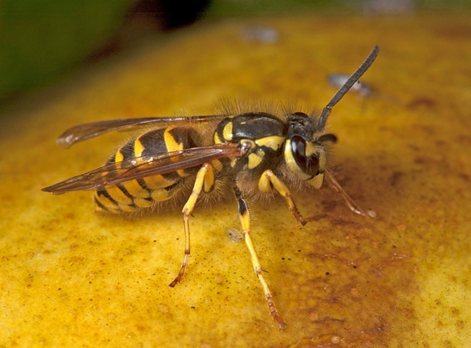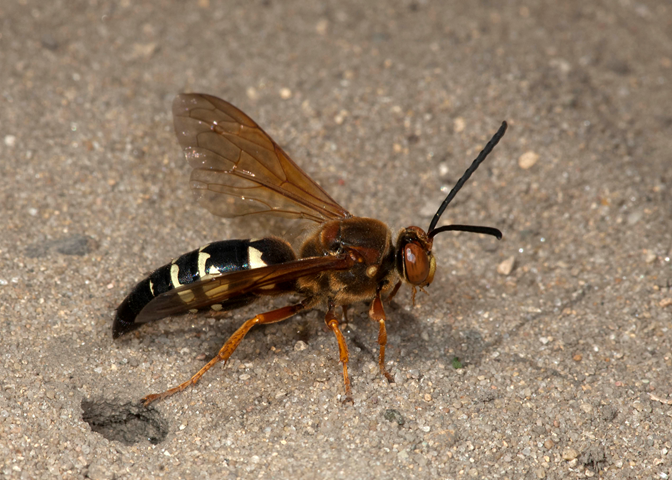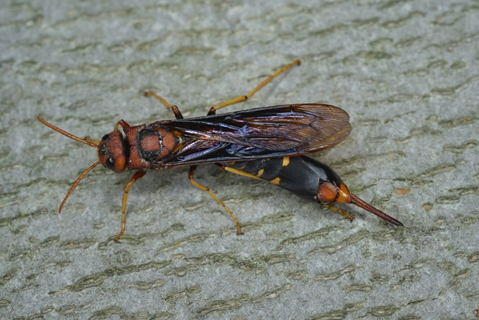Northern giant hornets
Information about the northern giant hornet (Vespa mandarinia), what they look like and what their status is in North America, in relation to Ontario.
Overview
Northern giant hornets (Vespa mandarinia) are also known as Japanese giant hornets and have been referred to as ‘murder hornets’ in the media.
They are the largest species of hornet in the world and are native to temperate and tropical regions in China, Korea, Japan and northern India.
Northern giant hornets are predatory as they hunt insects for food, including honey bees. These hornets pose a serious threat to Ontario’s agriculture and native biodiversity, including resident bees and wasps. They can also destroy honey bee colonies in less than 24 hours.
These hornets are generally not interested in humans, pets or large animals, but they can aggressively attack humans or animals if they get too close to a nest or a honey bee colony that is being attacked.
Northern giant hornets cannot be verified without a specimen or a photograph. Identification must be confirmed by a specialist such as an entomologist or taxonomist. See the Report a sighting section of this page for more information.
About hornets
- hornets are a type of wasp, which is a stinging insect
- Vespa is a genus (category) of social wasps that live in large colonies composed of a queen and hundreds of workers
- all the species of “true hornets” (members of the genus Vespa) are native to Eurasia and northern Africa; none are native to North America
- several Asian hornet species are considered serious predators of honey bees, the type of bees managed by beekeepers in Canada
- due to the potential threat to managed honey bees, two species of hornets native to Asia – Vespa mandarinia (northern giant hornets) and Vespa velutina (yellow-legged hornet) – are named pests in Regulation 57 under the Ontario Bees Act
Characteristics
- Northern giant hornets are generally much larger than any other hornet and most wasps found in Ontario or North America
- they have large, thick heads and can vary in colour; they can be different shades of orange, yellow and brown
- worker hornets are approximately 3.5 cm in length
- queens can be up to 4 to 5 cm in length, with a wingspan of 4 to 7 cm
- the hornets normally build nests in the ground and typically forage within a 1 km radius, but are known to go as far as 8 km from the nest
- Northern giant hornets may be confused with other species of wasps that occur in Ontario; they can only be confirmed by an expert or specialist
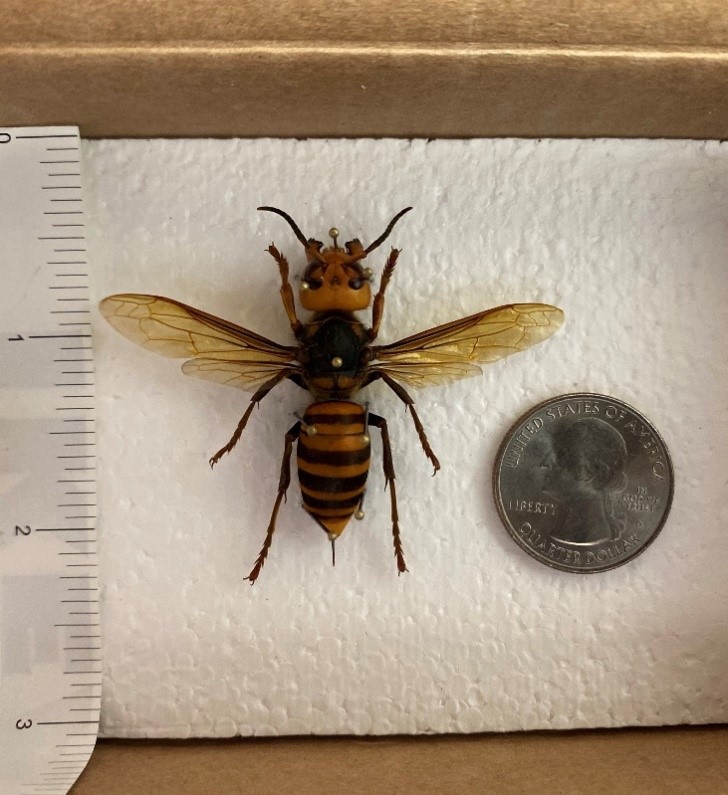
Figure 1: A specimen of Vespa mandarinia (northern giant hornet) that is about 4 to 5 centimetres (2 inches) long. Northern giant hornets have large yellow/orange heads with black eyes. The abdomen has alternating yellow/orange and brown bands encircling it. Photo source: Shirley Xanthe, USDA.
Status in Ontario
Northern giant hornets are not present in Ontario, and it is unknown if they can survive Ontario winters.
Commonly mistaken species
Northern giant hornets may be confused with other species of wasps and insects that are present in Ontario. Some wasps can grow longer and thinner and others are large but have different and distinct features on their body. Here are the most commonly reported species that are confused for the northern giant hornet.
European hornet
The European hornet, Vespa crabro, is regularly mistaken for the northern giant hornet. This species was accidentally introduced into eastern North America more than 160 years ago and today it is common in parts of Ontario. It is a very large wasp (2.5-3.5 centimetres), but much smaller than a northern giant hornet.
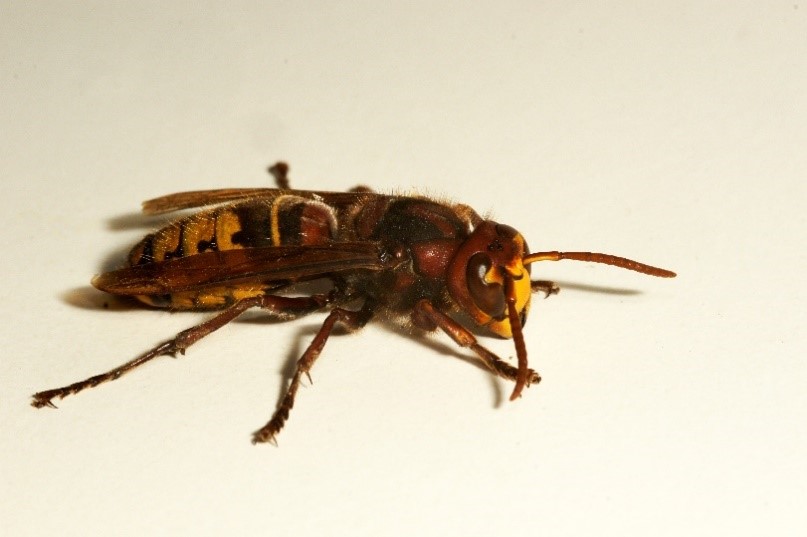
Bald-faced hornet
The Bald-faced hornet (Dolichovespula maculata), which is common throughout Ontario, also lives in large nests and is a social wasp, but is much smaller than a northern giant hornet.
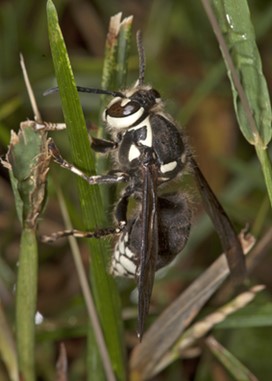
Yellowjacket
Yellowjackets are large, social, predaceous wasps that range from approximately 1 to 2.5 centimeters (0.5 - 1 inches) in length. The term yellowjacket refers to all species of the genera (categories) Dolichovespula and Vespula. This includes yellow and black marked species such as the common wasp (Figure 4) as well as black and white marked species such as the Bald-faced hornet (Figure 3). Most yellowjacket species are social and build nests out of wood fibres in tree branches or overhangs (Dolichovespula species) or in sheltered spaces within buildings or cavities in the ground (Vespula species). Female wasps can give a painful sting and will aggressively protect their nests. Most species of yellowjackets in Ontario are native. While a queen is larger than the typical workers usually encountered in summer, they are still smaller than a northern giant hornet.
Figure 4: A common wasp (Vespula vulgaris). This species has yellow and black markings. It is a large, social insect that ranges from approximately 1 to 2.5 centimetres (0.5 - 1 inches) in length. Photo source: Steve Marshall, University of Guelph.
Eastern Cicada Killer
The Eastern Cicada Killer, Sphecius speciosa, is a large ((1.5 - 5 centimetre (0.6 – 2 inches)) long solitary wasp. This wasp is native to eastern North America and occurs in parts of southwestern Ontario. Females are usually encountered around areas with open compacted soil including walkways, playgrounds and unpaved parking lots, where they can be seen making burrows in the ground. Multiple females may nest in the same area, but use separate burrows. Both males and females may approach people, but not aggressively; while the females can sting, they will do so only in self defense (for example, if held in forcibly in your hand).
Figure 5: Eastern Cicada Killer (Sphecius speciosa). This species has a dark body with broken bands of yellow on its abdomen. It is a large, solitary wasp that is about 1.5 to 5 centimeters (0.6 - 2 inches) long. Photo credit: Steve Marshall, University of Guelph.
Pigeon horntail
The Pigeon horntail, Tremex columba, is another species regularly mistaken for the northern giant hornet. It belongs to a group of insects often referred to as sawflies, where females have long saw-like ovipositors to deposit eggs into plant tissue. They are solitary insects, are not aggressive and cannot sting. The Pigeon horntail is native to Ontario. It is a large insect (2.5 - 3 centimetres), but still smaller than a northern giant hornet.
Pigeon horntail (Tremex columba). This species of horntail has a dark body with red, yellow and orange markings on the body. It has a long saw-like ovipositor. It is a large, solitary insect that is about 2.5 to 3 centimetres (1 inch) long. Photo credit: Steve Marshall, University of Guelph.
Northern giant hornets in Canada
The northern giant hornet was first confirmed in North America in British Columbia and nearby Washington State in 2019. Since then authorities in both British Columbia and Washington State have been continuing to monitor the situation.
It is not known how the northern giant hornet came to North America or how many introductions have occurred.
There is no evidence of the northern giant hornet anywhere else in North America.
Risk to humans
The northern giant hornet is generally not interested in pets, large animals or humans. However, they may aggressively attack if you get too close to their nest or a honey bee colony that is being preyed on.
Multiple stings from northern giant hornets have been known to cause anaphylaxis, severe toxicity and death due to large amounts of venom injected by the hornet during an attack.
Regular beekeeping suits do not provide protection against the stings from a northern giant hornet. Specialized protective equipment is required.
Risk to honey bees
Northern giant hornets are predators of honey bees.
From spring to mid-summer, these hornets are predators of individual honey bees. As the season progresses and as their colonies expand, northern giant hornets can attack full-sized honey bee colonies, killing all the bees within the colony in a short period of time (less than 24 hours).
What Ontario beekeepers can do
Ontario beekeepers should remain vigilant for pests when in their yards, including the northern giant hornet.
The best thing Ontario beekeepers can do is learn about the distribution and biology of the northern giant hornet and remain vigilant for this hornet and any other new or emerging pests and diseases of honey bees.
According to the Ontario Bees Act, any beekeeper who finds a pest or disease in their bees must immediately report the presence of the pest or disease.
Report a sighting
If you see a suspected northern giant hornet in Ontario, please report it by completing the online reporting form. For photographs, a clear image is needed of the specimen for species confirmation. To help with species identification purposes, follow the tips below for submitting photographs:
- ensure all images are in colour and in focus
- provide images of the following two views:
- the back surface of the insect
- the side of the insect
For technical issues, contact the Agricultural Information Contact Centre (AICC) at
Control methods
The best method of control is to prevent the introduction of any invasive pest or species.
Other methods of control such as trapping and physical or chemical destruction are being examined.
Governments in British Columbia and Washington State are working with the Canadian Food Inspection Agency (CFIA) and the United States Department of Agriculture (USDA) to conduct surveillance and to eradicate any future potential nests of northern giant hornets.
Other actions we are taking
Ontario is working with other jurisdictions to manage this hornet in North America.
Beekeepers in Ontario were informed of the status of the northern giant hornet in western North America in 2020 by the Provincial Apiarist. If there are changes in the status of this pest, we will update all Ontario beekeepers with notices sent through the Ontario Apiary Program and the Ontario Beekeepers’ Association.
Ontario is a member of several multi-jurisdictional committees and working groups which are gathering more information on northern giant hornets. These committees are also developing general protocols and guidelines for addressing this pest in North America.
